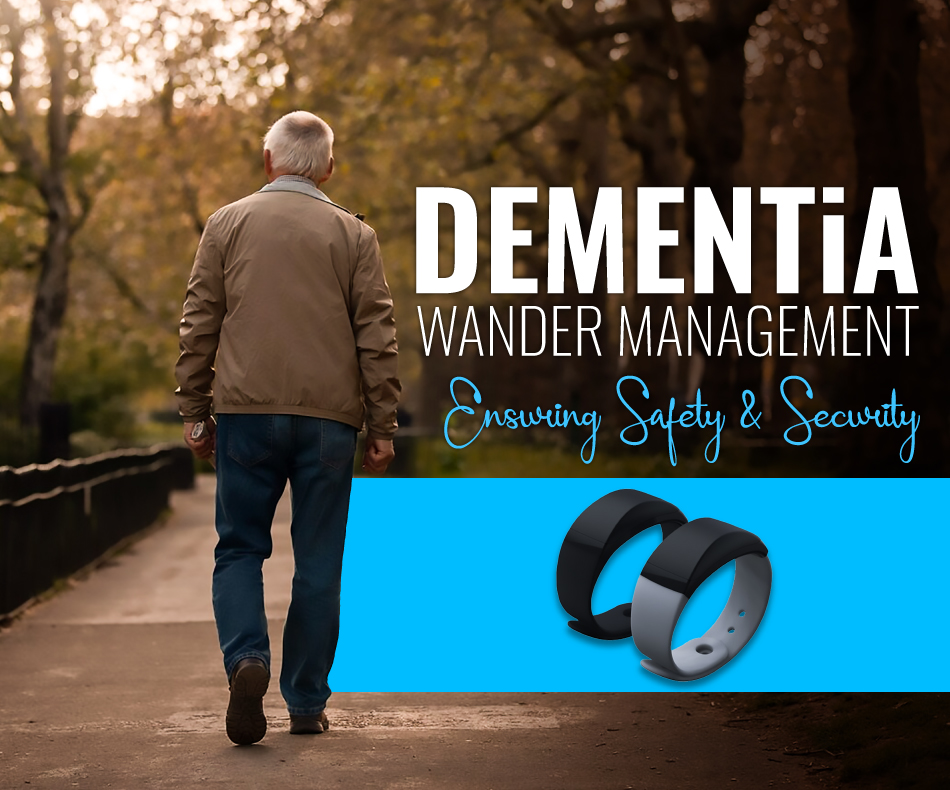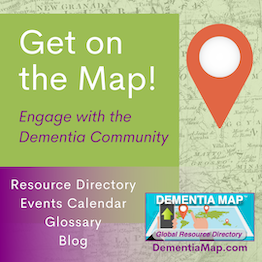Memory Cafe Directory posts and/or links to retailers can be advertising, sponsored, or affiliate links. We may earn a small commission from them. Thank you.
Dementia is a complex and challenging condition affecting millions of people worldwide, not only those diagnosed with it but also their families and caregivers. One of the distressing and potentially dangerous behaviors associated with dementia is wandering.
Wandering can pose severe risks to the safety and security of individuals with dementia, and it’s crucial to understand and effectively manage this issue. In this article, we will delve into the world of dementia and wander management, exploring what it is, why it happens, and how to ensure the safety and security of those affected.
What is Wander Management?
Wander management, also known as wandering prevention or elopement prevention, is a comprehensive approach to address the tendency of individuals with dementia to wander. This behaviour can lead to dangerous situations, as those who wander may get lost, injured, or exposed to environmental hazards.
Wander management encompasses various strategies, technologies, and interventions designed to reduce the risks associated with wandering. These strategies aim to balance ensuring the safety and security of individuals with dementia while respecting their autonomy and dignity.
What to Do if Your Loved One Wanders Away?
If a loved one with dementia wanders away, it can be a distressing and anxiety-inducing experience. Here are some steps to follow if such a situation arises:
1. Stay Calm: Your immediate reaction should be to stay as calm as possible. Panic may hinder your ability to think clearly.
2. Search Nearby: Start by searching the immediate vicinity. Many individuals with dementia do not travel far when they wander.
3. Inform Authorities: Contact local law enforcement if you need help locating your loved one quickly. They can initiate a search and use their resources to help find the missing person.
4. Provide a Description: Be prepared to provide a detailed description of your loved one, including their name, physical appearance, and any distinctive clothing or accessories they might be wearing.
5. Alert Neighbors: Inform neighbors about the situation and ask if they have seen your loved one.
6. Use Technology: Consider using tracking devices or GPS technology, if available, to help locate your loved one more efficiently.
7. Prevent Future Incidents: Once the immediate situation is resolved, prevent future wandering incidents. This might involve improving home security or seeking professional guidance. If they still drive, this may be a good time to remove the car keys.
Memory care centers are well-equipped to manage wandering in seniors with dementia. They employ a range of strategies to ensure the safety and well-being of residents who may wander. These strategies often include secure, well designed environments with locked or monitored exit doors and pathways to prevent wandering into potentially dangerous areas.
Additionally, staff members in memory care facilities are specially trained to understand the needs of residents with dementia and to recognize the signs of restlessness or the desire to wander. Engaging activities, structured routines, and regular supervision are also crucial components of managing wandering behaviors.
Furthermore, some memory care facilities use technology, such as wearable tracking devices, to monitor the movements of residents and provide alerts when they approach restricted areas. Overall, memory care facilities prioritize a balance between promoting independence and ensuring safety, making them a suitable choice for seniors with dementia who are prone to wandering.
Understanding the Reasons & Causes Behind Dementia Wandering
Understanding why people with dementia wander is essential to develop effective wander management strategies. Several factors can contribute to this behavior:
1. Memory Loss: Individuals with dementia often experience memory loss and may not remember where they are or how to return home.
2. Restlessness: Restlessness and agitation are common symptoms of dementia, prompting individuals to wander to relieve their discomfort.
3. Confusion: Cognitive decline can lead to confusion about time and place, causing people to wander while searching for something or someone familiar.
4. Unmet Needs: Basic needs like hunger, thirst, or the need to use the restroom can drive a person with dementia to wander in search of these necessities.
5. Past Routines: People with dementia may try to recreate routines from their past, such as going to work or visiting a former residence.
6. Environmental Triggers: Specific environmental cues, such as the sight of an open door or a familiar voice, can trigger wandering.
Why do People who are Living with Dementia Wander?
Understanding the motivation behind wandering in individuals with dementia is crucial for implementing effective wander management strategies. Seniors with dementia may walk for a variety of reasons, including:
1. Routine and Habit: Some individuals with dementia may wander because it was a part of their daily routine before their condition progressed. They may wander or engage in familiar activities like walking to a previous workplace.
2. Searching for Something: Dementia can distort the individual’s perception of reality, leading them to believe they are looking for something or someone, even if it doesn’t exist.
3. Restlessness and Anxiety: Memory care facilities for seniors with dementia recognize that cognitive decline can create turmoil and anxiety in individuals with dementia. Wandering may be an attempt to alleviate these feelings.
4. Miscommunication: Difficulty expressing their needs and desires can lead to frustration and wandering as an outlet for communication.
5. Boredom: The lack of stimulation and engagement can cause lethargy, prompting individuals to wander in search of activities or interactions.
6. Disorientation: People with dementia often experience disorientation, making them unaware of their current location or situation, leading to wandering.
How to Keep Dementia Patients from Wandering?
Preventing wandering in dementia patients requires a multi-faceted approach to addressing their needs and triggers. Here are some strategies to consider:
1. Establish a Routine: Consistency and structure can comfort dementia patients, reducing the urge to wander. Create a daily schedule that includes meals, activities, and rest.
2. Engage in Meaningful Activities: Keeping individuals with dementia engaged in enjoyable activities can reduce restlessness and boredom. Activities like puzzles, art, music, or reminiscence therapy can be beneficial.
3. Secure the Environment: Implement safety measures within the living space, such as locking the front door and windows or installing alarms and motion sensors to alert caregivers when someone is attempting to leave.
4. Provide Identification: Ensure your loved one always wears identification with their name and a contact number. This can be invaluable if they wander and are found by someone else.
5. Use Tracking Technology: GPS tracking devices and wearable technology can help caregivers locate their loved ones if they wander.
6. Medication Management: In some cases, medication may be prescribed to manage the restlessness and anxiety associated with dementia, reducing the risk of wandering.
7. Ensure Basic Needs Are Met: Regularly check if your loved one is comfortable, well-fed, hydrated, and has access to a restroom to minimize the chances of wandering in search of unmet needs.
8. Educate Caregivers: Family members and caregivers should be educated about the causes and potential signs of wandering and the best practices for managing it.
Signs that a Person with Dementia May Be at Risk for Wandering
Recognizing the signs that a person with dementia may be at risk for wandering is crucial for implementing proactive measures. Look out for the following indicators:
1. Restlessness: An increase in restlessness or pacing may indicate that the person is feeling anxious or agitated, increasing the likelihood of wandering.
2. Frequent Confusion: This is a warning sign if the individual frequently seems disoriented and unable to recognize familiar places or people.
3. Repetitive Questions or Actions: Repeatedly asking the same questions or engaging in the same actions can signal distress or disorientation.
4. Attempts to Leave: Repeated attempts to leave the home or wander outside should be taken seriously, especially without appropriate clothing or shoes.
5. Asking to Go Home: If the person continually desires to go home, even when already home, it may indicate wandering tendencies.
6. Restlessness at Night: Sundowning, a phenomenon where confusion and agitation worsen in the evening, can lead to night-time wandering.
Steps & Ideas for Managing & Preventing Wandering for a Person with Dementia
Managing and preventing wandering in a person with dementia involves a combination of practical and compassionate approaches. Here are some steps and ideas to consider:
1. Evaluate the Living Environment: Assess the safety of the person’s living space. Ensure that doors and windows are secure, and consider installing locks or alarms that signal when they are opened.
2. Create a Calm Environment: Reduce noise, clutter, and other distractions that may increase restlessness or anxiety.
3. Use Visual Cues: To help people navigate their surroundings, use visual cues like labels or pictures on doors to indicate the bathroom or bedroom.
4. Offer Reassurance: When someone desires to leave or feels anxious, provide reassurance and comfort. Acknowledge their feelings and offer empathy.
5. Maintain a Consistent Routine: Consistency can help reduce anxiety. Establish a daily routine and adhere to it as closely as possible.
6. Supervise When Necessary: When wandering risk is high, consider providing constant supervision or using respite care to ensure the person’s safety.
7. Medication Consultation: Consult with a healthcare professional to explore medication options if restlessness and anxiety are severe and negatively impact the person’s quality of life.
8. Familiar Activities: Engage the person in knowledgeable and enjoyable activities to keep them occupied and reduce restlessness.
9. Wearable Tracking Devices: Invest in wearable tracking devices or GPS technology that allows you to monitor the person’s location and be alerted if they wander.
How to Manage Wandering Behavior in Someone with Dementia?
When a person with dementia exhibits wandering behavior, it is crucial to manage it effectively to ensure their safety. Here are some management techniques to consider:
1. Calm and Redirect: Approach the person calmly and redirect their attention to a different, engaging activity or topic.
2. Distract and Divert: Use distraction techniques to divert their focus away from wandering. Engage them in a conversation or an enjoyable task.
3. Provide Supervision: In some cases, constant supervision or the presence of a caregiver may be necessary to prevent wandering.
4. Engage in Physical Activity: Encourage regular physical activity to help reduce restlessness and increase overall well-being.
5. Maintain a Safe Environment: Ensure the person’s living space is secure and free from hazards that could lead to accidents.
6. Consult Healthcare Professionals: If wandering is causing significant distress or safety concerns, consult healthcare professionals for guidance and possible treatment options.
What to Look for in a Wander Management Solution?
Selecting the right wander management solution is crucial for ensuring the safety and security of individuals with dementia. Here are vital factors to consider when evaluating a solution:
1. Effectiveness: The solution should have a proven track record of effectively preventing or managing wandering incidents.
2. Ease of Use: It should be user-friendly for individuals with dementia and their caregivers.
3. Reliability: The solution should be reliable and provide consistent results.
4. Cost: Consider the cost of implementing the solution, including any subscription fees, equipment, or installation expenses.
5. Integration: Ensure the solution can be easily integrated into the person’s daily routine and living environment.
6. Customization: Look for a solution tailored to the individual’s needs and behaviors.
7. Support and Training: Evaluate the customer support and training level provided by the solution provider.
8. Safety Features: Check for additional safety features like fall detection or emergency notifications.
Preventive Measures & Strategies of Dementia Wander Management
Prevention is a critical aspect of wander management. Here are some preventative measures and strategies to consider:
1. Educate Caregivers: Caregivers should receive training on recognizing and managing wandering behavior.
2. Foster a Secure Environment: Make necessary modifications to the living environment, including installing locks, alarms, and secure gates.
3. Implement Routine Check-Ins: Regularly check on the person, especially during periods of increased wandering risk.
4. Use Technology: Employ tracking devices, alarms, and surveillance cameras to monitor the person’s movements.
5. Medication Management: Consult a healthcare professional to determine if medication can help manage restlessness and anxiety.
6. Engage in Physical Activity: Encourage regular exercise to reduce restlessness and improve overall well-being.
7. Support Groups: Joining dementia caregiver support groups can provide valuable insights and strategies for wander management.
Tips to Reduce Dementia Wandering
Reducing dementia wandering is a collaborative effort that involves caregivers, family members, and healthcare professionals. Here are some tips to help minimize wandering incidents:
1. Create a Safe Haven: Designate a specific room or area in the home where the person can safely explore and engage in activities without the risk of wandering.
2. Use Familiar Music: Playing familiar music can be calming and reduce restlessness.
3. Provide Engaging Activities: Offer a variety of engaging activities that match the person’s interests and abilities.
4. Limit Caffeine and Sugar: Reducing caffeine and sugar intake can help manage restlessness and anxiety.
5. Limit Triggers: Identify and minimize triggers prompting wandering, such as excessive noise or clutter.
6. Consult a Specialist: If wandering is a significant concern, consult a specialist who can provide personalized strategies and recommendations.
Conclusion
Wandering in individuals living with Alzheimer’s Disease or other types of dementia can be a distressing and dangerous behavior that requires thoughtful management and prevention strategies. Understanding the reasons and causes behind walking, recognizing the signs, and implementing effective wander management solutions are crucial for ensuring the safety and security of individuals with dementia.
By providing a secure and supportive environment and compassionate care, we can help individuals with dementia live their lives with dignity and reduce the risks associated with wandering. For more information, reach out to organizations that provide a safe return program like Project Lifesaver. The Alzheimer’s Association can be another source of information.






